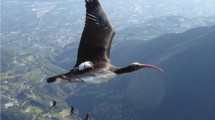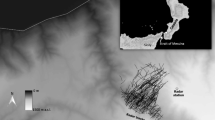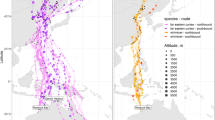Abstract
Billions of seasonally migrating birds and insects use two principal modes of flight, i.e., flapping and soaring–gliding. Flight mode is known to have strong effects on energy expenditure and speed of migration, yet its influence on the migratory track has rarely been investigated. Using radio telemetry, we studied the effects of crosswind on European Bee-eaters (Merops apiaster) during their spring migration with respect to different flight modes. Flapping, soaring–gliding, and mixed flight in which the birds flapped during gliding were distinguished by radio signals while the birds were flying en route over southern Israel. The regional atmospheric modeling system was applied in high spatial (1 km × 1 km) and temporal (5 min) resolution to estimate winds encountered aloft. We analyzed data from 11 birds that flew over a total distance of 810 km and found that lateral drift due to side wind did not differ among birds engaged in different flight modes. Overall, there was almost no effect of crosswind speed on bird lateral speed, as the regression slope was 0.31 (indicting mild lateral drift) and the regression’s R 2 was 0.01. Therefore, we conclude that migrating bee-eaters compensated for crosswind during their spring migration and that this response was not dependent on bird flight mode.
Zusammenfassung
Ziehende Bienenfresser kompensieren die durch Seitenwinde verursachte seitliche Abdrift
Milliarden saisonal migrierender Vögel und Insekten benutzen zwei unterschiedliche Flugtechniken, den Ruderflug und den Segel- und Gleitflug. Es ist bekannt, dass die Flugtechnik die Energiekosten und die Geschwindigkeit der Zuges stark beeinflusst. Der Einfluss der Flugtechnik auf die Migrationsroute wurde bisher jedoch kaum untersucht. Mittels Radiotelemetrie haben wir den Einfluss von Seitenwinden auf den Frühjahrszug von Bienenfressern (Merops apiaster) untersucht. Während die Vögel über Südisrael flogen, konnten Ruderflug, Segel- und Gleitflug und Flügelschlag während des Gleitfluges aufgrund der Funksignale unterschieden werden. Das Regional Atmospheric Modeling System wurde mit einer hohen räumlichen (250 m × 250 m) und zeitlichen (5 Minuten) Auflösung angewandt um die auftretenden Winde zu berechnen. Die Daten von elf Vögeln, die eine Gesamtstrecke von 810 km geflogen sind, wurden von uns analysiert. Die seitliche Abdrift durch Seitenwinde unterschied sich nicht zwischen den unterschiedlichen Flugtechniken. Es gab insgesamt fast keinen Effekt der Geschwindigkeit der Seitenwinde auf die Geschwindigkeit der seitlichen Abdrift der Vögel. Die Steigung der Regressionsgerade war 0,31 (was nur geringe seitliche Abdrift anzeigt) und R 2 der Regression war 0,01. Daraus schließen wir, dass die migrierenden Bienenfresser während ihres Frühjahrszugs Seitenwinde kompensiert haben und dass die Flugtechnik keinen Einfluss auf diese Kompensation hatte.



Similar content being viewed by others
References
Alerstam T (1975) Crane Grus grus migration over sea and land. Ibis 117:489–495
Alerstam T (1979) Wind as selective agent in bird migration. Ornis Scand 10:76–93
Alerstam T (1990) Bird migration. Cambridge University Press, Cambridge
Alerstam T, Hedenström A (1998) The development of bird migration theory. J Avian Biol 29:343–369
Alerstam T, Lindström Å (1990) Optimal bird migration: the relative importance of time, energy, and safety. In: Gwinner E (ed) Bird migration: the physiology and ecophysiology. Springer, Berlin, pp 331–351
Alerstam T, Chapman JW, Bäckman J, Smith AD, Karlsson H, Nilsson C, Reynolds DR, Klaassen RHG, Hill JK (2011) Convergent patterns of long-distance nocturnal migration in noctuid moths and passerine birds. Proc R Soc Lond B 278:1339–1346. doi:10.1098/rspb.2010.2106
Baudinette RV, Schmidt-Nielsen K (1974) Energy cost of gliding flight in herring gulls. Nature 248:83–84
Bevan RM, Butler PJ, Woakes AJ, Prince PA (1995) The energy expenditure of free-ranging black-browed albatrosses. Phil Trans R Soc Lond B 350:119–131
Bohrer G, Brandes D, Mandel JT, Bildstein KL, Miller TA, Lanzone M, Katzner T, Maisonneuve C, Tremblay JA (2012) Estimating updraft velocity components over large spatial scales: contrasting migration strategies of golden eagles and turkey vultures. Ecol Lett 15:96–103
Bruderer B, Liechti F (1995) Variation in density and height distribution of nocturnal migration in the south of Israel. Isr J Zool 4:477–487
Chapman JW, Reynolds DR, Mouritsen H, Hill JK, Riley JR, Sivell D, Smith AD, Woiwod IP (2008) Wind selection and drift compensation optimize migratory pathways in a high-flying moth. Curr Biol 18:514–518
Chapman JW, Nesbit RL, Burgin LE, Reynolds DR, Smith AD, Middleton DR, Hill JK (2010) Flight orientation behaviors promote optimal migration trajectories in high-flying insects. Science 327:682–685
Cochran WW (1972) Long-distance tracking of birds. In: Galler SR, Schmidt-Koenig K, Jacobs GJ, Belleville RE (eds) Animal orientation and navigation. NASA, Washington, DC, pp 39–59
Cochran WW (1975) Following a migrating peregrine from Wisconsin to Mexico. Hawk Chalk 14:28–37
Cochran WW (1987) Orientation and other migratory behaviors of a Swainson’s thrush followed for 1500 km. Anim Behav 35:927–929
Cochran WW, Kjos CG (1985) Wind drift and migration of thrushes: a telemetry study. Ill Nat Hist Surv Bull 33:297–330
Cochran WW, Wikelski M (2005) Individual migratory tactics of New World Catharus thrushes: current knowledge and future tracking options from space. In: Marra P, Greenberg R (eds) Birds of two worlds. Smithsonian Press, Washington DC, pp 274–289
Cochran WW, Bowlin MS, Wikelski M (2008) Wingbeat frequency and flap-pause ratio during natural migratory flight in thrushes. Integ Comp Biol 48:134–151
Cotton WR, Pielke RA, Walko RL, Liston GE, Tremback CJ, Jiang H, McAnelly RL, Harrington JY, Nicholls ME, Carrio GG, McFadden JP (2003) RAMS 2001: current status and future directions. Meteorol Atmos Phys 82:5–29
Drake VA, Farrow RA (1988) The influence of atmospheric structure and motions on insect migration. Annu Rev Entomol 33:183–210
Duerr AE, Miller TA, Lanzone M, Brandes D, Cooper J, O’Malley K, Maisonneuve C, Tremblay J, Katzner T (2012) Testing an emerging paradigm in migration ecology shows surprising differences in efficiency between flight modes. PLoS One 7:e35548
Fry CH (1984) The Bee-eaters. T. and A. D. Poyser, Calton
Gibo DL, Pallett MJ (1979) Soaring flight of monarch butterflies, Danaus plexippus (Lepidoptera, Danaidae), during the late summer migration in southern Ontario. Can J Zool 57:1393–1401
Green M (2001) Is wind drift in migrating barnacle and brent geese, Branta leucopsis and Branta bernica, adaptive or non-adaptive? Behav Ecol Sociobiol 50:45–54
Green M, Alerstam T (2002) The problem of estimating wind drift in migrating birds. J Theor Biol 218:485–496
Gudmundsson GA, Alerstam T, Green M, Hedenström A (2002) Radar observations of Arctic bird migration at the Northwest Passage, Canada. Arctic 55:21–43
Halsey LG, Shepard ELC, Wilson RP (2011) Assessing the development and application of the accelerometry technique for estimating energy expenditure. Comp Biochem Physiol A 158:305–314
Hedenström A (1993) Migration by soaring or flapping flight in birds: the relative importance of energy cost and speed. Phil Trans R Soc Lond B 342:353–361
Hedenström A, Alerstam T (1995) Optimal flight speed of birds. Phil Trans R Soc Lond B 348:471–487
Holland RA, Wikelski M, Kümmeth F, Bosque C (2009) The secret life of oilbirds: new insights into the movement ecology of a unique avian frugivore. PLoS One 4:e8264
Karlsson H, Henningsson P, Bäckman J, Hedenström A, Alerstam T (2010) Compensation for wind drift by migrating swifts. Anim Behav 80:399–404
Klaassen RHG, Hake M, Strandberg R, Alerstam T (2011) Geographical and temporal flexibility in the response to crosswinds by migrating raptors. Proc R Soc Lond B 278:1339–1346
Liechti F (2006) Birds: blowin’ by the wind? J Ornithol 147:202–211
Liechti F, Bruderer B (1998) The relevance of wind for optimal migration theory. J Avian Biol 29:561–568
Lord RD, Bellrose FC, Cochran WW (1962) Radio telemetry of the respiration of a flying duck. Science 137:39–40
Nathan R, Sapir N, Trakhtenbrot A, Katul GG, Bohrer G, Otte M, Avissar R, Soons MB, Horn HS, Wikelski M, Levin SA (2005) Long-distance biological transport processes through the air: can nature’s complexity be unfolded in silico? Divers Distrib 11:131–137
Nathan R, Getz WM, Revilla E, Holyoak M, Kadmon R, Saltz D, Smouse PE (2008) A movement ecology paradigm for unifying organismal movement research. Proc Natl Acad Sci USA 105:19052–19059
Nathan R, Spiegel O, Fortmann-Roe S, Harel R, Wikelski M, Getz WM (2012) Using tri-axial acceleration data to identify behavioral modes of free-ranging animals: general concepts and tools illustrated for griffon vultures. J Exp Biol 215:986–996
Newton I (2007) The migration ecology of birds. Academic Press, London
Pennycuick CJ (1972) Soaring behaviour and performance of some East African birds observed from a motorglider. Ibis 114:178–218
Pennycuick CJ (2008) Modelling the flying bird. Elsevier/Academic Press, Amsterdam
Pennycuick CJ, Alerstam T, Larsson B (1979) Soaring migration of the common crane Grus grus observed by radar and from an aircraft. Ornis Scand 10:241–251
Pennycuick CJ, Griffin L, Colhoun K, Angwin R (2011) A trial of a non-statistical computer program for monitoring fuel reserves, response to wind and other details from GPS tracks of migrating geese. J Ornithol 152:87–99
Pielke RA, Cotton WR, Walko RL, Tremback CJ, Lyons WA, Grasso LD, Nicholls ME, Moran MD, Wesley DA, Lee TJ, Copeland JH (1992) A comprehensive meteorological modeling system—RAMS. Meteorol Atmos Phys 49:69–91
Richardson WJ (1978) Timing and amount of bird migration in relation to weather: a review. Oikos 30:224–272
Richardson WJ (1990) Timing and amount of bird migration in relation to weather: updated review. In: Gwinner E (ed) Bird migration: the physiology and ecophysiology. Springer, Berlin, pp 78–101
Riley JR, Reynolds DR, Smith AD, Edwards AS, Osborne JL, Williams IH, McCartney HA (1999) Compensation for wind drift by bumble-bees. Nature 400:126
Sapir N, Wikelski M, McCue MD, Pinshow B, Nathan R (2010) Flight modes in migrating European Bee-eaters: heart rate may indicate low metabolic rate during soaring and gliding. PLoS One 5:e13956
Sapir N, Wikelski M, Avissar R, Nathan R (2011a) Timing and flight mode of departure in migrating European Bee-eaters in relation to multi-scale meteorological processes. Behav Ecol Sociobiol 65:1353–1365
Sapir N, Horvitz N, Wikelski M, Avissar R, Mahrer Y, Nathan R (2011b) Migration by soaring or flapping: numerical atmospheric simulations reveal that turbulence kinetic energy dictates bee-eater flight mode. Proc R Soc B 278:3380–3386
Shamoun-Baranes J, van Loon E (2006) Energetic influence on gull flight strategy selection. J Exp Biol 209:3489–3498
Shamoun-Baranes J, van Loon E, van Gasteren H, van Belle J, Bouten W, Buurma L (2006) A comparative analysis of the influence of weather on the flight altitudes of birds. Bull Am Meteorol Soc 87:47–61
Srygley RB (2001) Compensation for fluctuations in crosswind drift without stationary landmarks in butterflies migrating over seas. Anim Behav 61:191–203
Srygley RB (2003) Wind drift compensation in migrating dragonflies Pantala (Odonata : libellulidae). J Insect Behav 16:217–232
Srygley RB, Dudley R (2008) Optimal strategies for insects migrating in the flight boundary layer: mechanisms and consequences. Integ Comp Biol 48:119–133
Srygley RB, Oliveira EG, Dudley R (1996) Wind drift compensation, flyways, and conservation of diurnal, migrant Neotropical Lepidoptera. Proc R Soc Lond B 263:1351–1357
Stull RB (1988) An introduction to boundary layer meteorology. Kluwer Academic, Dordrecht
Thomas PJ, Labrosse AK, Pomeroy AC, Otter KA (2011) Effects of weather on avian migration at proposed ridgeline wind energy sites. J Wildl Manage 75:805–815
Thorup K, Alerstam T, Hake M, Kjellén N (2003) Bird orientation: compensation for wind drift in migrating raptors is age dependent. Proc R Soc Lond B 270:S8–S11
Walko RL, Band LE, Baron J, Kittel TGF, Lammers R, Lee TJ, Ojima D, Pielke RA, Taylor C, Tague C, Tremback CJ, Vidale PL (2000) Coupled atmosphere-biophysics-hydrology models for environmental modeling. J Appl Meteorol 39:931–944
Williams CB (1957) Insect migration. Ann Rev Entomol 2:163–180
Acknowledgments
We would like to thank Reuven Yosef, Tzadok Tzemah, William W. Cochran, Itzik Simhayof, Ofir Altstein, David Troupin, Yitzhak Mahrer, Adi Ben-Nun, Erica Kim, and members of the tracking teams and Movement Ecology Laboratory for their assistance. We thank the Israeli Meteorological Service and especially Amos Porat for providing the meteorological measurements and related information. We thank Thomas Alerstam for his constructive comments on a previous version of the manuscript. This work was supported by the US–Israel Binational Science Foundation (grant no. 229/2002 & 124/2004), the Ring Foundation for Environmental Research, and the Robert Szold Fund for Applied Science. N.S. was supported by two Rieger–JNF fellowships and a Fulbright doctoral dissertation travel fellowship.
Conflict of interest
None.
Ethical standard
Bird trapping permits were obtained from the Israeli Nature and Parks Authority (permits 2005/22055, 2006/25555), and the experimental procedure was approved by the Animal Care and Use Committee of the Hebrew University of Jerusalem (permit NS–06–07–2).
Author information
Authors and Affiliations
Corresponding author
Rights and permissions
About this article
Cite this article
Sapir, N., Horvitz, N., Wikelski, M. et al. Compensation for lateral drift due to crosswind in migrating European Bee-eaters. J Ornithol 155, 745–753 (2014). https://doi.org/10.1007/s10336-014-1060-x
Received:
Revised:
Accepted:
Published:
Issue Date:
DOI: https://doi.org/10.1007/s10336-014-1060-x




